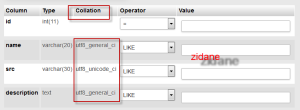However, UTF-8 encoding can pose some challenges when working with PHP and MySQL, two popular technologies for web development. PHP is a scripting language that can be embedded in HTML and used to create dynamic web pages. MySQL is a relational database management system that can store and retrieve data for web applications. Both PHP and MySQL support UTF-8 encoding, but they may not always handle it correctly or consistently.
One of the common problems that can arise when using UTF-8 encoding with PHP and MySQL is the display of garbled or corrupted characters on web pages. This can happen when the encoding settings of different components are not aligned or configured properly. For example, if the web server, the database server, the PHP script, and the HTML document are not all using UTF-8 encoding, then the text may not be displayed correctly.
To solve this problem, there are some steps that can be taken to ensure that all components are using UTF-8 encoding and communicating with each other correctly. These steps include:
• Setting the default character set and collation for the MySQL database and tables to UTF-8. This can be done by using the CREATE DATABASE and CREATE TABLE statements with the CHARACTER SET and COLLATE options, or by altering the existing database and tables with the ALTER DATABASE and ALTER TABLE statements.
• Setting the connection character set and collation for PHP and MySQL to UTF-8. This can be done by using the mysqli_set_charset function in PHP, or by executing the SET NAMES 'utf8' query in MySQL.
• Setting the content type header for the HTML document to UTF-8. This can be done by using the header function in PHP, or by adding a <meta> tag in the HTML <head> section.
• Saving the PHP script and the HTML document as UTF-8 files. This can be done by using a text editor that supports UTF-8 encoding, such as Notepad++ or Sublime Text.
By following these steps, the UTF-8 encoding problem in PHP and MySQL can be solved, and the text can be displayed correctly on web pages. This will ensure that the web application can support multiple languages and scripts, and provide a better user experience.
Explore My Other Channel for More Cool and Valuable Insights
👉 Youtube Learn Tech Tips👉 Tiktok
👉 Facebook:Follow my steps
1. On phpmyadmin, you must set your database with utf8_general_ci2. On HTML code, add this:
<meta http-equiv="content-type" content="text/html; charset=utf-8">
</meta>
3. On PHP code, you must add this code in your project
$conn->query("SET NAMES 'utf8' COLLATE 'utf8_unicode_ci'");
#utf8 #php #mysql #encoding #webdevelopment
Thank you for reading this post. I hope you found it helpful and easy to follow. If you have any feedback or questions about
How to Solving the UTF-8 Encoding Problem in PHP and MySQL ,
please share them in the comments below. I would love to hear from you and discuss this topic further
✋✋✋✋
Webzone Tech Tips Zidane, all things tech tips web development
- I am Zidane, See you next time soon ✋✋✋✋












